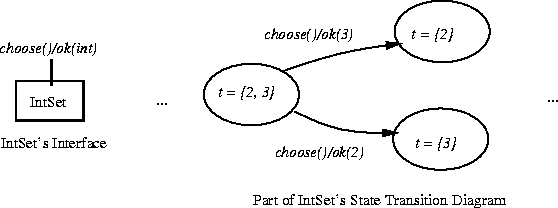
Suppose I have an integer set, t, and in its interface is a choose action that doesn't take any arguments and removes and returns an element from t.

where choose is specified as follows:
1
chooseĒ()/ok(int) pre

post

You might notice that the labels on the arcs in the
state transition diagram above are different (by what is returned by
choose);
however, most people would still view the state transition function
as nondeterministic because they would abstract from the
actual
value returned. In other words they would define ![]() something like this:
something like this:
![]()
Finally, in a programming language that supports exception handling I would probably export a more robust interface for the choose action:
1
chooseĒ()/okĒ (int), empty() pre true
post


1
actionĒ(inputs)/ 
pre

post

I'm glossing over a number of technicalities here regarding state variables to store input arguments and the type of the result returned, depending on how an action terminates.
Finally, for simplicity, let's assume actions return only normally unless specified otherwise (by explicitly listing exceptional conditions in their headers). Under this default case, we can avoid clutter in our specifications by not always having to write ``terminates = ok'' in the post-conditions of our actions.